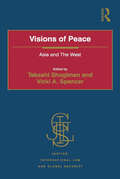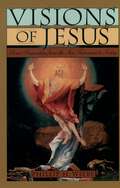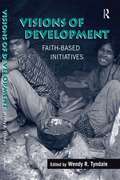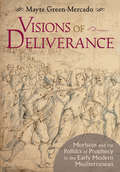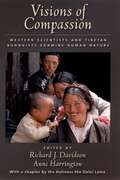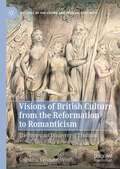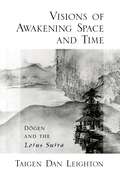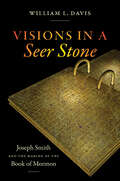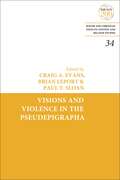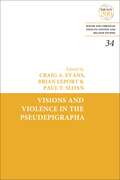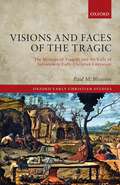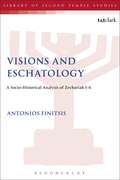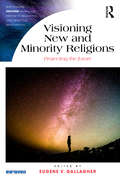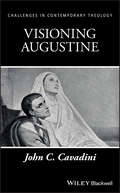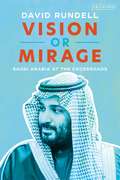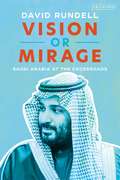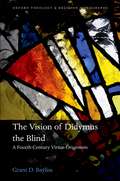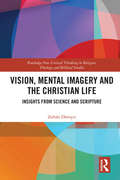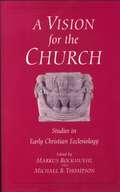- Table View
- List View
Visions of Peace: Asia and The West (Justice, International Law and Global Security)
by Vicki A. Spencer Takashi ShogimenVisions of Peace: Asia and the West explores the diversity of past conceptualizations as well as the remarkable continuity in the hope for peace across global intellectual traditions. Current literature, prompted by September 11, predominantly focuses on the laws and ethics of just wars or modern ideals of peace. Asian and Western ideals of peace before the modern era have largely escaped scholarly attention. This book examines Western and Asian visions of peace that existed prior to c.1800 by bringing together experts from a variety of intellectual traditions. The historical survey ranges from ancient Greek thought, early Christianity and medieval scholasticism to Hinduism, classical Confucianism and Tokuguwa Japanese learning, before illuminating unfamiliar aspects of peace visions in the European Enlightenment. Each chapter offers a particular case study and attempts to rehabilitate a 'forgotten' conception of peace and reclaim its contemporary relevance. Collectively they provide the conceptual resources to inspire more creative thinking towards a new vision of peace in the present. Students and specialists in international relations, peace studies, history, political theory, philosophy, and religious studies will find this book a valuable resource on diverse conceptions of peace.
Visions of Jesus: Direct Encounters from the New Testament to Today
by Phillip H. WiebeErnie Hollands, a career criminal, said Christ appeared to him in his cell in Millhaven Penitentiary. Maria Martinez saw Jesus at a busy intersection in Miami, Florida. Rose Fairs was lying in bed one morning when the Venetian blinds opened and the head of Jesus materialized before her. Were these people only imagining a figure that seemed life-like, or is there a chance that what they saw was, in some way, real? This first critical study of contemporary visions of Jesus offers the intriguing accounts of thirty people, most of them ordinary men and women without prior or subsequent experiences of this kind, who remain mystified about their encounters. Wiebe recounts each vision in vivid detail, exploring why these individuals believe their visions were of Jesus, and why they typically believe them to be objective happenings, rather than hallucinations or dreams. He regards the occurrences from perspectives as diverse as biblical scholarship and parapsychology, concluding that they may well represent genuine religious experiences of a mystical character. The fascinating nature of these visions and Wiebe's thoughtful, evenhanded approach to each report add up to a book that will be provocative reading for skeptics and the faithful alike.
Visions of Development: Faith-based Initiatives
by Wendy R. TyndaleVisions of Development presents first-hand stories of groups and movements from many different religious and spiritual traditions that are working with impoverished communities in Africa, Asia and Latin America. It provides unique insights into how people's beliefs and spirituality can help to inform not only what they perceive 'development' to be but also how they go about achieving it. Through real-life examples of courageous and innovative work, the stories challenge much of the theory and practice of mainstream development agencies while also showing how religious inspiration can be a force for radical and positive change.
Visions of Development: Faith-based Initiatives
by Wendy R. TyndaleVisions of Development presents first-hand stories of groups and movements from many different religious and spiritual traditions that are working with impoverished communities in Africa, Asia and Latin America. It provides unique insights into how people's beliefs and spirituality can help to inform not only what they perceive 'development' to be but also how they go about achieving it. Through real-life examples of courageous and innovative work, the stories challenge much of the theory and practice of mainstream development agencies while also showing how religious inspiration can be a force for radical and positive change.
Visions of Deliverance: Moriscos and the Politics of Prophecy in the Early Modern Mediterranean
by Mayte Green-MercadoIn Visions of Deliverance, Mayte Green-Mercado traces the circulation of Muslim and crypto-Muslim apocalyptic texts known as joferes through formal and informal networks of merchants, Sufis, and other channels of diffusion among Muslims and Christians across the Mediterranean from Constantinople and Venice to Morisco towns in eastern Spain. The movement of these prophecies from the eastern to the western edges of the Mediterranean illuminates strategies of Morisco cultural and political resistance, reconstructing both productive and oppositional interactions and exchanges between Muslims and Christians in the early modern Mediterranean.Challenging a historiography that has primarily understood Morisco apocalyptic thought as the expression of a defeated group that was conscious of the loss of their culture and identity, Green-Mercado depicts Moriscos not simply as helpless victims of Christian oppression but as political actors whose use of end-times discourse helped define and construct their society anew. Visions of Deliverance helps us understand the implications of confessionalization, forced conversion, and assimilation in the early modern period and the intellectual and theological networks that shaped politics and identity across the Mediterranean in this era.
Visions of Compassion: Western Scientists and Tibetan Buddhists Examine Human Nature
by Richard J. Davidson Anne HarringtonThis book examines how Western behavioral science--which has generally focused on negative aspects of human nature--holds up to cross-cultural scrutiny, in particular the Tibetan Buddhist celebration of the human potential for altruism, empathy, and compassion. Resulting from a meeting between the Dalai Lama, leading Western scholars, and a group of Tibetan monks, this volume includes excerpts from these extraordinary dialogues as well as engaging essays exploring points of difference and overlap between the two perspectives.
Visions of British Culture from the Reformation to Romanticism: The Protestant Discovery of Tradition (Histories of the Sacred and Secular, 1700–2000)
by Celestina Savonius-WrothThis book is a major new contribution to the study of cultural identities in Britain and Ireland from the Reformation to Romanticism. It provides a fresh perspective on the rise of interest in British vernacular (or “folk”) cultures, which has often been elided with the emergence of British Romanticism and its Continental precursors. Here the Romantics’ discovery of and admiration for vernacular traditions is placed in a longer historical timeline reaching back to the controversies sparked by the Protestant Reformation. The book charts the emergence of a nuanced discourse about vernacular cultures, developing in response to the Reformers’ devastating attack on customary practices and beliefs relating to the natural world, seasonal festivities, and rites of passage. It became a discourse grounded in humanist Biblical and antiquarian scholarship; informed by the theological and pastoral problems of the long period of religious instability after the Reformation; and, over the course of the eighteenth century, colored by new ideas about culture drawn from Enlightenment historicism and empiricism. This study shows that Romantic literary primitivism and Romantic social thought, both radical and conservative, grew out of this rich context. It will be welcomed by historians of early modern and eighteenth-century Britain and those interested in the study of religious and vernacular cultures.
Visions of Awakening Space and Time: Dōgen and the Lotus Sutra
by Taigen Dan LeightonAs a religion concerned with universal liberation, Zen grew out of a Buddhist worldview very different from the currently prevalent scientific materialism. Indeed, says Taigen Dan Leighton, Zen cannot be fully understood outside of a worldview that sees reality itself as a vital, dynamic agent of awareness and healing. In this book, Leighton explicates that worldview through the writings of the Zen master Eihei Dōgen (1200-1253), considered the founder of the Japanese Sōtō Zen tradition, which currently enjoys increasing popularity in the West. The Lotus Sutra, arguably the most important Buddhist scripture in East Asia, contains a famous story about bodhisattvas (enlightening beings) who emerge from under the earth to preserve and expound the Lotus teaching in the distant future. The story reveals that the Buddha only appears to pass away, but actually has been practicing, and will continue to do so, over an inconceivably long life span. Leighton traces commentaries on the Lotus Sutra from a range of key East Asian Buddhist thinkers, including Daosheng, Zhiyi, Zhanran, Saigyo, Myōe, Nichiren, Hakuin, and Ryōkan. But his main focus is Eihei Dōgen, the 13th century Japanese Sōtō Zen founder who imported Zen from China, and whose profuse, provocative, and poetic writings are important to the modern expansion of Buddhism to the West. Dōgen's use of this sutra expresses the critical role of Mahayana vision and imagination as the context of Zen teaching, and his interpretations of this story furthermore reveal his dynamic worldview of the earth, space, and time themselves as vital agents of spiritual awakening. Leighton argues that Dōgen uses the images and metaphors in this story to express his own religious worldview, in which earth, space, and time are lively agents in the bodhisattva project. Broader awareness of Dōgen's worldview and its implications, says Leighton, can illuminate the possibilities for contemporary approaches to primary Mahayana concepts and practices.
Visions of Awakening Space and Time: Dōgen and the Lotus Sutra
by Taigen Dan LeightonAs a religion concerned with universal liberation, Zen grew out of a Buddhist worldview very different from the currently prevalent scientific materialism. Indeed, says Taigen Dan Leighton, Zen cannot be fully understood outside of a worldview that sees reality itself as a vital, dynamic agent of awareness and healing. In this book, Leighton explicates that worldview through the writings of the Zen master Eihei Dōgen (1200-1253), considered the founder of the Japanese Sōtō Zen tradition, which currently enjoys increasing popularity in the West. The Lotus Sutra, arguably the most important Buddhist scripture in East Asia, contains a famous story about bodhisattvas (enlightening beings) who emerge from under the earth to preserve and expound the Lotus teaching in the distant future. The story reveals that the Buddha only appears to pass away, but actually has been practicing, and will continue to do so, over an inconceivably long life span. Leighton traces commentaries on the Lotus Sutra from a range of key East Asian Buddhist thinkers, including Daosheng, Zhiyi, Zhanran, Saigyo, Myōe, Nichiren, Hakuin, and Ryōkan. But his main focus is Eihei Dōgen, the 13th century Japanese Sōtō Zen founder who imported Zen from China, and whose profuse, provocative, and poetic writings are important to the modern expansion of Buddhism to the West. Dōgen's use of this sutra expresses the critical role of Mahayana vision and imagination as the context of Zen teaching, and his interpretations of this story furthermore reveal his dynamic worldview of the earth, space, and time themselves as vital agents of spiritual awakening. Leighton argues that Dōgen uses the images and metaphors in this story to express his own religious worldview, in which earth, space, and time are lively agents in the bodhisattva project. Broader awareness of Dōgen's worldview and its implications, says Leighton, can illuminate the possibilities for contemporary approaches to primary Mahayana concepts and practices.
Visions in a Seer Stone: Joseph Smith and the Making of the Book of Mormon
by William L. DavisIn this interdisciplinary work, William L. Davis examines Joseph Smith's 1829 creation of the Book of Mormon, the foundational text of the Latter Day Saint movement. Positioning the text in the history of early American oratorical techniques, sermon culture, educational practices, and the passion for self-improvement, Davis elucidates both the fascinating cultural context for the creation of the Book of Mormon and the central role of oral culture in early nineteenth-century America.Drawing on performance studies, religious studies, literary culture, and the history of early American education, Davis analyzes Smith's process of oral composition. How did he produce a history spanning a period of 1,000 years, filled with hundreds of distinct characters and episodes, all cohesively tied together in an overarching narrative? Eyewitnesses claimed that Smith never looked at notes, manuscripts, or books—he simply spoke the words of this American religious epic into existence. Judging the truth of this process is not Davis's interest. Rather, he reveals a kaleidoscope of practices and styles that converged around Smith's creation, with an emphasis on the evangelical preaching styles popularized by the renowned George Whitefield and John Wesley.
Visions and Violence in the Pseudepigrapha (Jewish and Christian Texts)
by Craig A. Evans Brian LePort and Paul T. SloanThe nine essays that make up this volume provide cutting-edge studies of how sacred tradition is given new expression through vision and interpretation. The first four essays focus on the expansion of the sacred tradition primarily through vision. The evolution of the Solomon legacy, from wise king to healer and exorcist, is explored, as well as its contribution to the demonology of the desert fathers, especially as it concerns eroticism and sexual temptation. The varied receptions of the Revelation of the Magi and Shepherd of Hermas are also considered. The remaining five essays address important questions relating to polemic and violence in the Pseudepigrapha. How does the author of the Liber Antiquitatum Biblicarum justify God's alternating judgment and favor? How does Enoch's Animal Apocalypse make use of the Exodus tradition in its expression of deliverance? On what basis can the author of Qumran's War Scroll confidently predict Israel's vindication? And finally, what accounts for the appearance of the tradition of Gehenna, in which the wicked will meet their fiery end?
Visions and Violence in the Pseudepigrapha (Jewish and Christian Texts)
by Brian Leport Craig A. Evans Paul T. SloanThe nine essays that make up this volume provide cutting-edge studies of how sacred tradition is given new expression through vision and interpretation. The first four essays focus on the expansion of the sacred tradition primarily through vision. The evolution of the Solomon legacy, from wise king to healer and exorcist, is explored, as well as its contribution to the demonology of the desert fathers, especially as it concerns eroticism and sexual temptation. The varied receptions of the Revelation of the Magi and Shepherd of Hermas are also considered. The remaining five essays address important questions relating to polemic and violence in the Pseudepigrapha. How does the author of the Liber Antiquitatum Biblicarum justify God's alternating judgment and favor? How does Enoch's Animal Apocalypse make use of the Exodus tradition in its expression of deliverance? On what basis can the author of Qumran's War Scroll confidently predict Israel's vindication? And finally, what accounts for the appearance of the tradition of Gehenna, in which the wicked will meet their fiery end?
Visions and Faces of the Tragic: The Mimesis of Tragedy and the Folly of Salvation in Early Christian Literature (Oxford Early Christian Studies)
by Paul M. BlowersDespite the pervasive early Christian repudiation of pagan theatrical art, especially prior to Constantine, this monograph demonstrates the increasing attention of late-ancient Christian authors to the genre of tragedy as a basis to explore the complexities of human finitude, suffering, and mortality in relation to the wisdom, justice, and providence of God. The book argues that various Christian writers, particularly in the post-Constantinian era, were keenly devoted to the mimesis, or imaginative re-presentation, of the tragic dimension of creaturely existence more than with simply mimicking the poetics of the classical Greek and Roman tragedians. It analyses a whole array of hermeneutical, literary, and rhetorical manifestations of "tragical mimesis" in early Christian writing, which, capitalizing on the elements of tragedy already perceptible in biblical revelation, aspired to deepen and edify Christian engagement with multiform evil and with the extreme vicissitudes of historical existence. Early Christian tragical mimetics included not only interpreting (and often amplifying) the Bible's own tragedies for contemporary audiences, but also developing models of the Christian self as a tragic self, revamping the Christian moral conscience as a tragical conscience, and cultivating a distinctively Christian tragical pathos. The study culminates in an extended consideration of the theological intelligence and accountability of "tragical vision" and tragical mimesis in early Christian literary culture, and the unique role of the theological virtue of hope in its repertoire of tragical emotions.
Visions and Faces of the Tragic: The Mimesis of Tragedy and the Folly of Salvation in Early Christian Literature (Oxford Early Christian Studies)
by Paul M. BlowersDespite the pervasive early Christian repudiation of pagan theatrical art, especially prior to Constantine, this monograph demonstrates the increasing attention of late-ancient Christian authors to the genre of tragedy as a basis to explore the complexities of human finitude, suffering, and mortality in relation to the wisdom, justice, and providence of God. The book argues that various Christian writers, particularly in the post-Constantinian era, were keenly devoted to the mimesis, or imaginative re-presentation, of the tragic dimension of creaturely existence more than with simply mimicking the poetics of the classical Greek and Roman tragedians. It analyses a whole array of hermeneutical, literary, and rhetorical manifestations of "tragical mimesis" in early Christian writing, which, capitalizing on the elements of tragedy already perceptible in biblical revelation, aspired to deepen and edify Christian engagement with multiform evil and with the extreme vicissitudes of historical existence. Early Christian tragical mimetics included not only interpreting (and often amplifying) the Bible's own tragedies for contemporary audiences, but also developing models of the Christian self as a tragic self, revamping the Christian moral conscience as a tragical conscience, and cultivating a distinctively Christian tragical pathos. The study culminates in an extended consideration of the theological intelligence and accountability of "tragical vision" and tragical mimesis in early Christian literary culture, and the unique role of the theological virtue of hope in its repertoire of tragical emotions.
Visions and Eschatology: A Socio-Historical Analysis of Zechariah 1-6 (The Library of Second Temple Studies #79)
by Antonios FinitsisZechariah 1-6 is unlike most of the prophets in the Hebrew Bible. He is pro-establishment and he conveys his message mostly with visions. These observations have led to scholarly disagreements as to how one should understand his role. Antonios Finitsis mediates this disagreement by triangulating the relationship of Zechariah's visionary mode of expression, his message and his function. Zechariah has often been seen as a link between prophecy and apocalypticism. However, Finitsis argues again assuming the presence of this link - warning against the potential for reductionist thinking. Furthermore, Proto-Zechariah's viewpoint is particular to the post-exilic social setting. His visions are influenced by the social circumstances in which they are expressed. Proto-Zechariah refers to the near future using elements from the community's present. Therefore, Finitsis defines the message of Proto-Zechariah one of restoration eschatology, suggesting that the text is addressed to a small province plagued by inner-community conflicts. The text succeeds in alleviating social discord by empowering the people to rebuild their community. This presents a unique and challenging understand of Zechariah's prophetic role.
Visioning New and Minority Religions: Projecting the future (Routledge Inform Series on Minority Religions and Spiritual Movements)
by Eugene V. GallagherRather than being ephemeral fads, new religious movements (NRMs) have always been and will always be with us. So will their study. Offering an assessment of the state-of-the-field of the study of NRMs, Visioning New and Minority Religions begins by considering the analytical tools for the study of new or minority religions, drawing on the perspectives of diverse academic disciplines. The second part focuses on individual groups in a variety of geographical settings. Chapters in this section review the histories of particular groups in order to extrapolate future developments. They cover new religions that have persisted well past the first generation, such as the Church of Jesus Christ of Latter-day Saints and the Christian Scientists, and groups with comparatively shorter histories, such as various forms of contemporary Paganism, Soka Gakkai, and the Diamond Way Buddhist group. This volume will be of interest to scholars from across religious studies and sociology, as well as members of new and minority religious groups and those in "cult watching" groups.
Visioning New and Minority Religions: Projecting the future (Routledge Inform Series on Minority Religions and Spiritual Movements)
by Eugene V. GallagherRather than being ephemeral fads, new religious movements (NRMs) have always been and will always be with us. So will their study. Offering an assessment of the state-of-the-field of the study of NRMs, Visioning New and Minority Religions begins by considering the analytical tools for the study of new or minority religions, drawing on the perspectives of diverse academic disciplines. The second part focuses on individual groups in a variety of geographical settings. Chapters in this section review the histories of particular groups in order to extrapolate future developments. They cover new religions that have persisted well past the first generation, such as the Church of Jesus Christ of Latter-day Saints and the Christian Scientists, and groups with comparatively shorter histories, such as various forms of contemporary Paganism, Soka Gakkai, and the Diamond Way Buddhist group. This volume will be of interest to scholars from across religious studies and sociology, as well as members of new and minority religious groups and those in "cult watching" groups.
Visioning Augustine (Challenges in Contemporary Theology)
by John C. CavadiniThe definitive compendium of Cavadini’s essays on Augustine Visioning Augustine offers readers an expertly selected collection of essays exploring the text and history of the theology of Saint Augustine. Prominent scholar and essayist, John Cavadini, offers modern audiences an innovative framework for understanding Augustine, integrating articles and essays on significant texts, historical and contemporary perspectives and insights into Augustine’s development as a theologian. Examining themes such as the transformation of the human will in De doctrina Christiana and Augustine’s critique of philosophy in City of God, Cavadini provides clear and accessible smaller-size essays that serve as entry points for those interested in Augustinian scholarship. The author’s meditations on Augustinian texts invite readers to re-evaluate their interpretations and learn about the subtle and sophisticated vocabulary of Augustine. An encounter with Augustine the Christian theologian, Cavadini contends, is not a narrowly focused parochial experience, but instead a challenge to enlarge our horizons. Written by one of the most prominent Augustinian scholars and essayists in the field Addresses ecumenical and cultural issues that weaken contemporary interest in Christian faith Offers modern readers historical context on Augustinian theology Provides a single-volume collection of Cavadini’s essays on Augustine written over the course of more than two decades Accessible prose and intellectual sensitivity to modern theological problemsmake Visioning Augustine an indispensable volume for graduate students, scholars and professionals in all areas of Christian theology.
Visioning Augustine (Challenges in Contemporary Theology)
by John C. CavadiniThe definitive compendium of Cavadini’s essays on Augustine Visioning Augustine offers readers an expertly selected collection of essays exploring the text and history of the theology of Saint Augustine. Prominent scholar and essayist, John Cavadini, offers modern audiences an innovative framework for understanding Augustine, integrating articles and essays on significant texts, historical and contemporary perspectives and insights into Augustine’s development as a theologian. Examining themes such as the transformation of the human will in De doctrina Christiana and Augustine’s critique of philosophy in City of God, Cavadini provides clear and accessible smaller-size essays that serve as entry points for those interested in Augustinian scholarship. The author’s meditations on Augustinian texts invite readers to re-evaluate their interpretations and learn about the subtle and sophisticated vocabulary of Augustine. An encounter with Augustine the Christian theologian, Cavadini contends, is not a narrowly focused parochial experience, but instead a challenge to enlarge our horizons. Written by one of the most prominent Augustinian scholars and essayists in the field Addresses ecumenical and cultural issues that weaken contemporary interest in Christian faith Offers modern readers historical context on Augustinian theology Provides a single-volume collection of Cavadini’s essays on Augustine written over the course of more than two decades Accessible prose and intellectual sensitivity to modern theological problemsmake Visioning Augustine an indispensable volume for graduate students, scholars and professionals in all areas of Christian theology.
Vision or Mirage: Saudi Arabia at the Crossroads
by David Rundell'Clear-eyed and illuminating' Henry Kissinger'A rich, superbly researched, balanced history of the modern Kingdom of Saudi Arabia'General David Petraeus 'Destined to be the best single volume on the Kingdom.' Ambassador Chas Freeman'Should be prescribed reading for a new generation of political leaders.'Sir Richard DearloveSomething extraordinary is happening in Saudi Arabia. A traditional, tribal society once known for its lack of tolerance is rapidly implementing significant economic and social reforms. An army of foreign consultants is rewriting the social contract, King Salman has cracked down hard on corruption, and his dynamic though inexperienced son, the Crown Prince Mohammad bin Salman, is promoting a more tolerant Islam. But is all this a new vision for Saudi Arabia or merely a mirage likely to dissolve into Iranian-style revolution?David Rundell - one of America's foremost experts on Saudi Arabia - explains how the country has been stable for so long, why it is less so today, and what is most likely to happen in the future. The book is based on the author's close contacts and intimate knowledge of the country where he spent 15 years living and working as a diplomat. Vision or Mirage demystifies one of the most powerful, but least understood, states in the Middle East and is essential reading for anyone interested in the power dynamics and politics of the Arab World.
Vision or Mirage: Saudi Arabia at the Crossroads
by David Rundell'Clear-eyed and illuminating' Henry Kissinger'A rich, superbly researched, balanced history of the modern Kingdom of Saudi Arabia'General David Petraeus 'Destined to be the best single volume on the Kingdom.' Ambassador Chas Freeman'Should be prescribed reading for a new generation of political leaders.'Sir Richard DearloveSomething extraordinary is happening in Saudi Arabia. A traditional, tribal society once known for its lack of tolerance is rapidly implementing significant economic and social reforms. An army of foreign consultants is rewriting the social contract, King Salman has cracked down hard on corruption, and his dynamic though inexperienced son, the Crown Prince Mohammad bin Salman, is promoting a more tolerant Islam. But is all this a new vision for Saudi Arabia or merely a mirage likely to dissolve into Iranian-style revolution?David Rundell - one of America's foremost experts on Saudi Arabia - explains how the country has been stable for so long, why it is less so today, and what is most likely to happen in the future. The book is based on the author's close contacts and intimate knowledge of the country where he spent 15 years living and working as a diplomat. Vision or Mirage demystifies one of the most powerful, but least understood, states in the Middle East and is essential reading for anyone interested in the power dynamics and politics of the Arab World.
The Vision of Didymus the Blind: A Fourth-Century Virtue-Origenism (Oxford Theology and Religion Monographs)
by Grant D. BaylissAn independent teacher, based in Alexandria throughout the second half of the fourth century, Didymus appealed to many within the broadly Origenist currents of Egyptian asceticism, including Jerome, Rufinus, and Evagrius. His commentaries, lecture-notes, and theological treatises show him specifically committed to the legacy of Origen and Philo, rather than a broader 'Alexandrian' or noetic reading of Scripture. Yet his concern was not to answer classic 'Antiochene' critique but rather offer a faithful continuation of many aspects of Origen's thought and exegesis, now made consistent with the broader anti-subordinationist developments in Nicene faith from the 350s onwards. In doing so he made virtue a primary category of reality, human existence, and life, in ways that go beyond the traditional philosophical tropes. This 'turn to virtue' draws parallels with wider fourth-century trends but it sets Didymus' own Origenism apart from those of other Origenists, such as Eusebius of Caesarea or Evagrius of Pontus. Thus detailed discussion focuses on Didymus' portrayal of virtue, sin, and passion, which together form the constant hermeneutical terrain for his anagogical exegesis and exhortation to a dynamic process of ascent. Speculative comments of Origen on the pre-existence of the soul, salvation of the devil, pre-passion, and the sin of Adam are shown to be reframed, both to aid the individual's navigation of the return to virtue and to answer the challenge of contemporary Manichaean and Apollinarian beliefs.
Vision, Mental Imagery and the Christian Life: Insights from Science and Scripture (Routledge New Critical Thinking in Religion, Theology and Biblical Studies)
by Zoltán DörnyeiThis book uniquely explores how the notion of vision is presented in modern science and the Bible, and how it can be applied to contemporary Christian contexts. The word "vision", our ability to see, has been described by an increasing body of scholarship in the social sciences as our capacity for mental imagery and imagination. As such, this unique cognitive capability has been utilised in many fields for a variety of purposes, from arts and psychotherapy to politics and business management, and even for performance enhancement in sports. The current book argues that a better understanding of vision can have far-reaching practical implications for Christian life and ministry by helping people to align themselves with God’s specific purposes. After a theoretical overview that integrates scientific and theological insights, the final chapters present a variety of strategies that can help believers to discern God’s call through the use of mental imagery and then to develop and cultivate the perceived vision. The book examines the scientific and biblical principles of vision in a comprehensive manner, with a special emphasis on the practical implications of the issue. As such, it will be of great interest to scholars of Theology, Biblical Studies and Church Growth/Leadership, as well as Organisational Behaviour, Business Management and Psychology.
Vision, Mental Imagery and the Christian Life: Insights from Science and Scripture (Routledge New Critical Thinking in Religion, Theology and Biblical Studies)
by Zoltán DörnyeiThis book uniquely explores how the notion of vision is presented in modern science and the Bible, and how it can be applied to contemporary Christian contexts. The word "vision", our ability to see, has been described by an increasing body of scholarship in the social sciences as our capacity for mental imagery and imagination. As such, this unique cognitive capability has been utilised in many fields for a variety of purposes, from arts and psychotherapy to politics and business management, and even for performance enhancement in sports. The current book argues that a better understanding of vision can have far-reaching practical implications for Christian life and ministry by helping people to align themselves with God’s specific purposes. After a theoretical overview that integrates scientific and theological insights, the final chapters present a variety of strategies that can help believers to discern God’s call through the use of mental imagery and then to develop and cultivate the perceived vision. The book examines the scientific and biblical principles of vision in a comprehensive manner, with a special emphasis on the practical implications of the issue. As such, it will be of great interest to scholars of Theology, Biblical Studies and Church Growth/Leadership, as well as Organisational Behaviour, Business Management and Psychology.
Vision for the Church: Studies in Early Christian Ecclesiology
by Markus Bockmuehl Michael B. ThompsonWhat is the Church? Perhaps more importantly, what is it meant to be? How did its earliest members understand this body of which they had become a part? This is a textbook collection of fifteen essays by an international group of New Testament experts. They bring together a dynamic range of perspectives on how the early Christians viewed the Church: its origins, purpose and relation to Jewish Scriptures and to Jesus Christ; its place in the world and in God's plan; its community life and worship, in theory and in practice.
